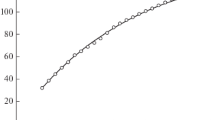Abstract
Features of the growth of a population of the polychaete worm Spiochaetopterus typicus from the Pechora Sea are studied based on its size and age structure. Using a linear modification of the Bertalanffy equation, some individuals are found to be able to last up to eight years, this being confirmed in practice by the number of annual layers on their tubes. Correlations between the diameter of the body, tubes, and weight of the worm are obtained. A method for calculating the biomass of S. typicus polychaetes with smaller errors is proposed based on the diameter of their tubes; in the case of mass material, the biomass should be calculated using an average value of polychaete individuals equal to 1.5 ± 0.2 g.



Similar content being viewed by others
REFERENCES
Alimov, A.F. and Golikov, A.N., Some regularities in the relationship between size and weight in mollusks, Zool. Zh., 1974, vol. 53, no. 4, pp. 517–530.
Brotskaya, V.A. and Zenkevich, L.A., Quantitative accounting of the benthic fauna of the Barents Sea, Tr. VNIRO, 1939, vol. 4, pp. 5–126.
Denisenko, S.G., Bioraznoobrazie i bioresursy makrozoobentosa Barentseva morya: struktura i mnogoletnie izmeneniya (Biodiversity and Bioresources of the Macrozoobenthos of the Barents Sea: Structure and Long-Term Changes), St. Petersburg: Nauka, 2013.
Filatova, Z.A. and Zenkevich, L.A., Quantitative distribution of the benthic fauna of the Kara Sea, Tr. VGBO, 1959, vol. 8, pp. 3–67.
Frolova, E.A., Fauna i ekologiya mnogoshchetinkovykh chervei (Polychaeta) Karskogo moray (Fauna and Ecology of Polychaetes (Polychaeta) of the Kara Sea), Apatity: Kol’sk. Nauchn. Tsentr Ross. Akad. Nauk, 2009.
Gagaev, S.Yu., Fauna mnogoshchetinkovykh chervei (Polychaeta) Vostochno-Sibirskogo morya i ikh biogeograficheskaya kharakteristika (Fauna of Polychaete Worms (Polychaeta) of the East Siberian Sea and Their Biogeographical Characteristics), Issled. Fauny Morei, St. Petersburg: Zool. Inst. Ross. Akad. Nauk, 2010, no. 63 (75), pp. 8–40.
Gagaev, S.Yu., Growth and bioenergetic features of the polychaete populations from Chaun Bay of the East Siberian Sea, Oceanology, 2004, vol. 44, no. 2, pp. 388–392.
Hammer, Ø., Harper, D.A.T., and Ryan, P.D., Paleontological statistics software package for education and data analysis, Palaeontol. Electron., 2001, no. 4 (1), pp. 1–9.
Semenov, V.N., Long-term changes in the biocenoses of the benthic fauna of the Kara Sea and neighboring water areas, in Ekologiya i bioresursy Karskogo morya (Ecology and Bioresources of the Kara Sea), Apatity: Kol’sk. Nauchn. Tsentr Akad. Nauk SSSR, 1989, pp. 145–150.
Walford, L.F., A new graphic method of describing the growth of animals, Biol. Bull., 1946, vol. 90, no. 2, pp. 141–147.
Zhirkov, I.A., Polikhety Severnogo Ledovitogo okeana (Polychaetes of the Arctic Ocean), Moscow: Yanus-K, 2001.
ACKNOWLEDGMENTS
The author is grateful for help in working on this article to the V.V. Potin, senior curator of the collection of higher worms of the Institute of Zoology, Russian Academy of Sciences, and to S.G. Denisenko and B.I. Sirenko, employees of the Institute of Zoology, Russian Academy of Sciences.
Funding
This work was carried out as part of the research on the topic of state budget financing “Taxonomy, Biodiversity, and Ecology of Invertebrates in Russian and Adjacent Waters of the World Ocean, Continental Water Bodies, and Humid Areas,” project no. 1021051402797-9, at the Zoological Institute, Russian Academy of Sciences, and with the financial support of the Russian Foundation for Basic Research, project no. 18-05-60157 “Secular Changes in the Bottom Ecosystems of the Arctic seas of Russia, Current State, and Forecast.” The study used the materials of the Unique Storage Collection, Institute of Zoology, Russian Academy of Sciences, no. 2-2.20 (http://www.ckp-rf.ru/usu/73561/).
Author information
Authors and Affiliations
Corresponding author
Ethics declarations
Conflict of interests. The author declares that he has no conflicts of interest.
Statement on the welfare of animals. All applicable international, national, and/or institutional guidelines for the care and use of animals were followed.
Rights and permissions
About this article
Cite this article
Gagaev, S.Y. Growth Features of the Polychaete Worm Spiochaetopterus typicus (Chaetopteridae). Biol Bull Russ Acad Sci 50, 1648–1652 (2023). https://doi.org/10.1134/S1062359023070087
Received:
Revised:
Accepted:
Published:
Issue Date:
DOI: https://doi.org/10.1134/S1062359023070087




